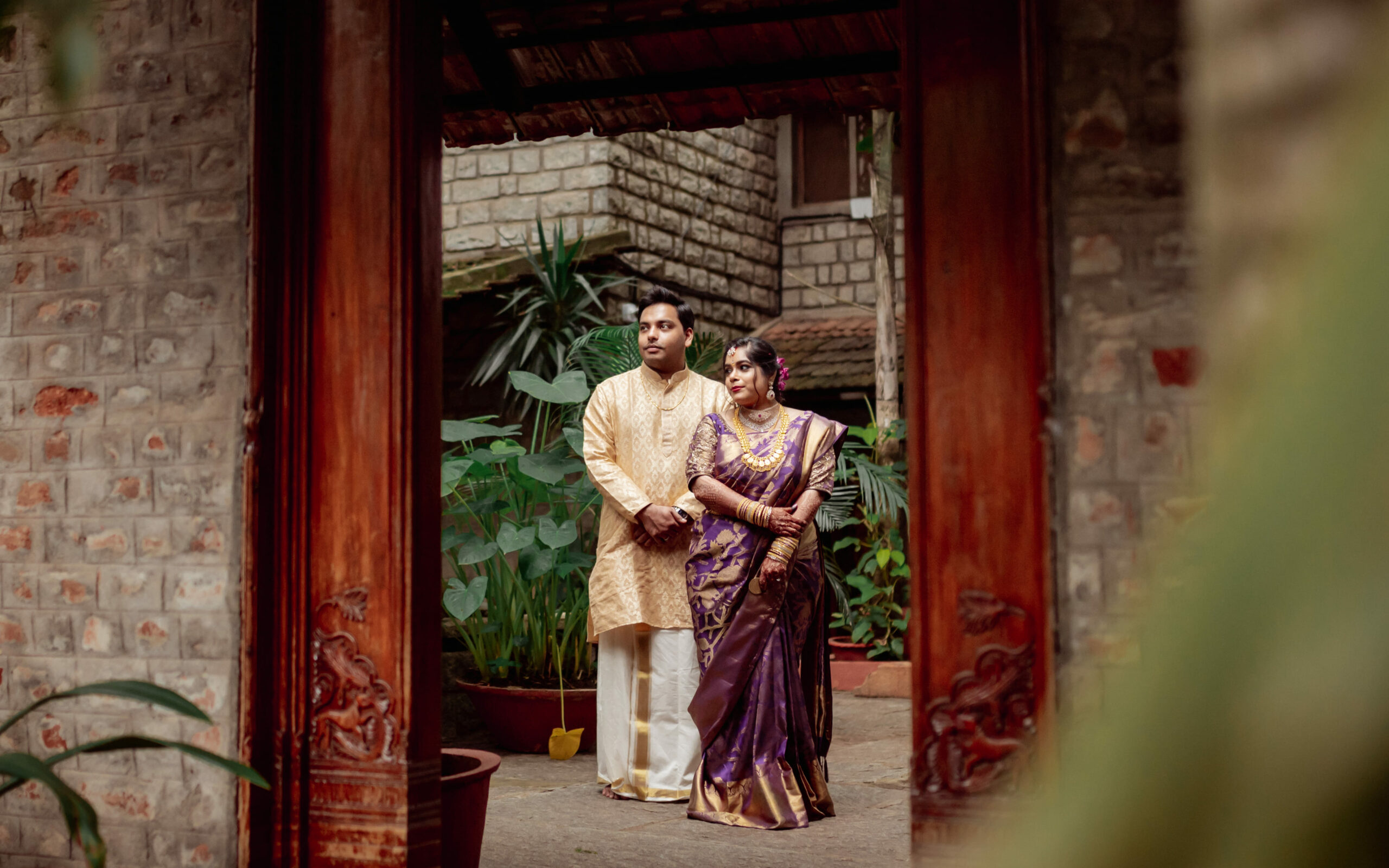MALAYALI WEDDING: RITUALS, CEREMONIES, ATTIRE & MORE!

A Malayali wedding, hailing from the culturally rich state of Kerala in southern India, is a captivating tale woven with rituals, symbolism, and deep-rooted traditions. Each ceremony and custom in a Malayali wedding serves a unique purpose, steeped in the history and heritage of the region.
From the exchange of garlands to the sacred tying of the Thaali, and the feast of Sadhya, there’s so much to do in a Kerala wedding. Read on to dive into the heart and soul of these rituals. We’ll explore the significance behind these age-old practices, the colorful attires adorned by the bride and groom, and the music and dance that fill the air with joy.

Bride’s attire
The traditional saree, which is precisely draped to perfection, is an essential component of a Malayali bride. The bride’s appeal is enhanced by the display of gold jewelry that goes with her elegant outfit.
The Kasumala, a stunning necklace made by stitching together gold coins, is the focal point of this jewelry. The Palakka Mothiram, a striking green gold necklace frequently adorned with exquisite designs like mango, is another item. A gold belt called an “oddiyanam” has decorative uses. The bride then dons the Jhukis, which often display jewelry with temple-inspired designs, to complete this majestic look. The Elakkathali, a magnificent gold choker that adorns the bride’s neck, completes the look.
Groom’s attire
The groom’s clothing in a Hindu wedding in Kerala perfectly combines white and gold, displaying a classic sense of elegance. The white Mundu, a traditional dhoti or lungi with a golden zari border, is the focal point of the groom’s attire. The Melmundu, a coordinating scarf, completes this outfit and adds a touch of class.
The groom traditionally wears the Mundu with a Kurta or a white shirt, giving off an appearance of elegance and sophistication. He too is adorned with a gold chain, and/or a gold bracelet.

Pre-wedding ceremonies
Muhurtham
Kundlis, the intricate birth charts meticulously matched for the bride and groom, serve as the celestial compass guiding the path to their union. These astrological charts play a pivotal role in determining the most auspicious date for the main wedding ceremony, where two souls intertwine their lives in love and commitment. It ensures that the celestial beings are perfectly aligned, ready to embrace the connection between the bride and groom. This time that is decided based on the couple’s birth chart is called the Muhurtham – the perfect time to tie the knot. This is one of the main steps followed in most South Indian weddings.

Nischayam
An engagement ceremony serves as the official proclamation of commitment. It’s the moment when the soon-to-be-wed couple gathers to exchange rings, symbolizing their mutual acceptance and promise to walk life’s journey hand in hand.
During this cherished ritual, two hearts merge as the couple gently slide rings onto each other’s fingers to symbolically represent their acceptance of each other.
Traditional Party / Ayinoon
What better way to start with the festivities than a traditional meal?
The Bride and the Groom’s party hosts a luncheon for all their relatives in their respective homes before the main ceremony officiates. Puttu with kadala curry, appam with stew, karimeen pollichathu, and Malabar parota with curry are a few of the traditional dishes of Kerala served at the Ayinoon or the traditional party . Pappadam is always found in the mix!
Main-day Wedding Rituals
Wedding bells ring in stripes of gold and white, and the fragrance of incense envelops the surroundings. In the quiet moments before the ceremony, the bride and groom share a palpable sense of trepidation, the butterflies of a new beginning fluttering within them. Their attire awaits them, its drapes meticulously pressed to adorn the bride and groom.
Dakshini
This ceremony brings both the bride and groom’s immediate family together for a brief gathering to bestow blessings upon the soon to be couple. Married and elderly of the family come to impart some advice and bless the couple with a beautiful married life.


Madhuparkam Ritual
In this cherished ritual, the bride’s family extends a warm welcome to the groom’s party. Female relatives and friends of the bride carry traditional lamps known as nilavilakku and containers filled with rice. The whole party proceeds to the wedding venue to welcome the groom with elements that symbolizes the acceptance of the groom and his family into the bride’s household. Rice is often considered as a symbol of prosperity and abundance. Traditionally, a significant gesture unfolds as the father of the bride ceremoniously washes the groom’s feet.
In a reciprocal gesture, the groom presents a pristine white saree to his future in-laws. This saree holds great significance as it will be worn by the bride on her wedding day. This exchange of gifts and traditions not only symbolizes the union of two individuals but also the coming together of two families in celebration and unity.


Saptapathi
A veli, a holy fire lit in the center of the mandap, is one of the most essential requirements of any Hindu wedding. Agni, the goddess of fire gives life to the marriage and hence is an important element of a wedding. The couple circles the veli three times which leads to him tying the thali around her neck. Thalam and Vilakku is present during this ritual, symbolizing the purity and sacredness of the marital union.

Thalikettu Kalyanam
In Malayalam weddings, the Thalikettu ceremony, where the groom ties the sacred Thali around the bride’s neck, is a central and significant event marked by music, festivities, and the vibrant beats of Chenda Melam—a traditional percussion instrument. The Chenda drum adds a festive touch to the wedding procession, creating an energetic ambiance. Additionally, during the Thalikettu ceremony, Thalam and Vilakku may be used on the ceremonial platform, symbolizing purity and auspiciousness. The thaalam is a decorative plate adorned with flowers, a brass lamp, an ivory and gold cloth fan, and in certain communities, it may include a small bowl of Adenanthera Pavonina seeds symbolizing luck. This entire process signifies the formalization of the marriage, and the inclusion of cultural elements like Chenda Melam, Thalam, and Vilakku enhances the joyous atmosphere of the occasion.


Kanyadaanam
These rituals ultimately lead to Kanyadaanam, where the father of the bride offers his daughter’s hand in marriage by placing her hand on the groom’s hand. During the Kanyadanam ceremony, the bride’s parents express their blessings and support for the union, acknowledging the beginning of a new chapter in their daughter’s life.

Sparsham Ritual
This ritual is carried out after Kanyaadanam. It’s the ritual where the bride and groom sit in front of each other with their foreheads in contact with each other. As a symbolic gesture of her new role and the beginning of her journey in her marital home, the bride lovingly tosses rice into the “veli,” a sacred space. With grace and assistance from the groom, she then places her foot upon the “ammi,” the grinding stone—a profound act that signifies her acceptance of new marital responsibilities and her transition into her new family.

Sadhya
The Malayali wedding feast, known as Sadhya, is a feast for all the guests who follow the wedding rituals. It begins with a selection of pickles, including spicy raw mango and sweet Puli Inchi, served with banana chips and Kerala pappadums.
Main dishes include Thoran, a coconut-infused cabbage or beans stir-fry, and Kalan, featuring yam cooked in yogurt and spices. The mildly-flavored Olan, Avial, Erissery, and Kootu Curry add diversity to the spread, all cooked with fresh vegetables and coconut.
Accompanying these dishes is par-boiled choru rice, served with Sambar, a coconut-lentil stew, followed by Rasam and spiced buttermilk. Desserts include Pal Ada Pradhaman, a milk and rice flakes delicacy, and Paruppu Payasam, lentils simmered in aromatic spices. The meal concludes with ripe bananas, creating a sumptuous and unforgettable Kerela Sadhya experience.
Post- wedding ceremonies
Kudivep
The bride’s welcoming ceremony into the groom’s home is a heartwarming tradition illuminated by oil lamps. This ritual serves as a warm embrace, symbolizing the bride’s transition into her new environment. Beyond its luminous charm, this ceremony holds a deeper purpose.
It is a thoughtful introduction to the bride’s new roles and responsibilities within her extended family. Through this tradition, she begins to familiarize herself with the customs, routines, and dynamics of her new home.

Grihapravesham
It’s a ritual performed along with a small ceremony to mainly welcome the bride and to pray for a harmonious transition of the bride into her new home. This ritual is a tender expression of welcome for the bride and a prayer for her harmonious transition into her new home.
As we conclude our journey through the enchanting Malayali wedding rituals, we invite you to consider The Tales of Tradition Wedding Planners. With a blend of cultural reverence and contemporary elegance, we specialize in crafting weddings that tell unique love stories. Let us be your guides in creating a celebration that transcends tradition, making every moment an unforgettable tale of love. Explore the magic of tradition with a modern twist – choose The Tales of Tradition for your wedding tale.

